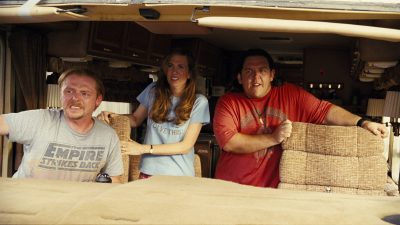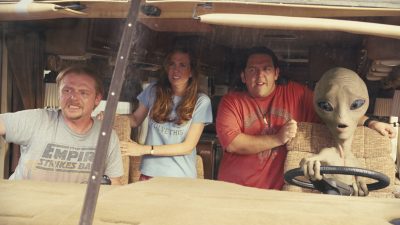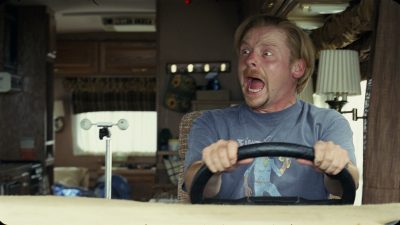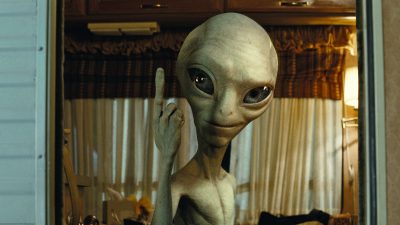With Paul, Double Negative adds to its already impressive list of visual effects credits through a major character animation show. We talk to animation supervisor Anders Beer and visual effects producer Hal Couzens about the film.
Paul follows the story of two sci-fi geeks, Graeme and Clive (played by Simon Pegg and Nick Frost) as they encounter an alien near the ubiquitous UFO sighting zone, Area 51. Taking the name ‘Paul’, the alien (voiced by Seth Rogen) escapes a top-secret military base and joins Graeme and Clive on a road trip adventure in their RV while eluding government agents. Director Greg Mottola sought to ensure Paul remained a traditional ‘Grey’ alien but with humanistic characteristics. Ultimately, Double Negative, under visual effects supervisor Jody Johnson, delivered 750 shots, made up of creature animation, an alien UFO and mothership and various other effects, with a crew of almost 300.
Designing a Grey
Paul exists in the film as a ‘Grey’ – having a characteristically large head, enormous eyes and familiar grey skin, although with a slightly greenish tinge. “They knew immediately they wanted it to be an alien that everyone could recognize,” observes Double Negative animation supervisor Anders Beer. “That meant we would have certain limitations as far as physique and range of movement was concerned. We would push towards something quite naturalistic, a little more human, and then we would come back to something that was very traditional and recognizable as the grey alien. You can see an iris in there and a pupil, but there’s still these 45 degree angle, almond-shaped eyes and no discernible hair on the brow.”


With a different head shape and without much hair, Double Negative had to experiment with ways of making Paul more sympathetic and recognizable when conveying emotion. “There were many discussions about how he needed to be alien but not be creepy or grotesque,” says Hal Couzens, Double Negative’s visual effects producer on the show. “The challenge was to hit the other-worldliness but keep him appealing and likable. The darkness of his eyes was something we had to work hard with, Greg wanted to retain them as dark as possible to satisfy that ‘Greys’ are described as having black almond shaped eyes. It was difficult to see his eyeline and feel his emotions when we were unable to see his pupils, so a fine balance had to be found.”
Shooting Paul
On location, production relied on several methods to provide on-set interaction for Paul, who would of course be added later by Double Negative. Joe Lo Truglio, who also plays an agent in the film, provided on-set off-camera performance to help the other actors with timings and interaction. “Joe would just put on a pair of kneepads and hide behind a chair or a bush or something and read the lines back,” says Beer. “We also had a guy called Christoph who was about the same height as Paul, and he would stand in to give us a sense of how quickly the alien would move through a scene. We would do a dry run with him and then the DP would try to re-create that for a clean plate.”
A team of puppeteers managed a full-sized rubber Paul, which was utilized for camera line-ups and lighting. “We also had a headless and armless version for Nick Frost to carry for when they flee the farmhouse,” says Couzens. “And Tanner, the stunt co-ordinator’s young son, was right for walking down the street dressed as a cowboy, jumping onto Agent Zoil’s (Jason Bateman) back and being hugged by Graeme and Clive.”
Double Negative used survey data from sets and camera positions captured with a Leica Total Station. Some locations and the interior of the RV were LIDAR scanned. “An HDRI lighting pass was also taken for every set-up,” adds Couzens. “On other occasions witness cameras were used to record more complex moving lighting situations. And the mysterious Winklefix (an angle measuring tool) made many appearances while shooting inside the RV.”
Almost all of the scenes inside the RV were shot on a greenscreen stage. “The size and number of windows and reflective surfaces in the RV and the unrepeatable nature of road footage required us to capture large arcs of the driving background in one go,” says Couzens. “For this, the grips and camera department designed and built a purpose-specific six camera mount on a camera vehicle. It comprised of three Libra heads each mounting two cameras. Remarkably, the camera car was able to drive fast enough in forward or reverse gear, sparing any need to change the camera mounts between set-ups. This also enabled a near 180 degree overlapping field of view to be captured in one take.”
“These interlocking frames,” continues Couzens, “needed to be synced with a bloop-light, de-lensed, stabilized and stitched together in post before being projected onto a sphere or planar surface, re-lensed, graded and composited into the green-screen of the RV plates. Dust and dirt was added where needed. It was a considerable and necessary amount of work in 400 plus shots that hopefully the viewer never really notices!”
Making Paul ‘Seth-like’
Although Seth Rogen lent his voice to Paul, the actor was not available during shooting of principal photography in New Mexico. Instead, Double Negative used a number of sources of reference for Paul’s speech, mannerisms and general behavior. Firstly, Rogen attended a rehearsal period in May 2009 on the Culver City soundstage. “Seth was there with the other actors and they did a dry run-through of all the lines,” explains Beer. “We had a number of witness cameras and facial cameras on him and we also got him into a Xsens MVN suit for motion capture.”

![pbh_031_120_v019_frame21[1].0021](https://www.fxguide.com/wp-content/uploads/2011/03/pbh_031_120_v019_frame211.0021-400x225.jpg)
Animators further relied on reference footage of themselves – some shot on flipcams – and motion capture data generated in-house. “That Xsens MVN suit is really flexible and affordable so we had one here in several sizes,” says Beer. “We would set up sessions where animators could jump in the suit and then capture their performances in 3D. You could block things in so quickly and see it on Paul, and get a choreography that the director could buy off on. Sometimes with video reference it’s harder to imagine a person who looks completely different to Paul working in the scene.”
Finally, a later re-recording session with Rogen was filmed and that footage used sparingly for additional reference. “We had a camera set up to capture his face,” says Beer, “but Seth was basically reading from a lectern with a big projection of the film in front of him. His eyeline never really made sense, so there wasn’t much we could do with that. The most we could get from that performance was a little bit of brow movement and lip sync.”
Modeling an alien
Working from a scan of an early Spectral Motion prototype foam latex build of Paul’s head, Double Negative embarked on a digital model of the alien. Later, a macquette was also provided, scanned and modeled, with various modifications made to the CG model throughout production.
Artists modeled mostly in Maya and ZBrush, with some work carried out in XSI. A base mesh from the macquette was added to with displacement details in ZBrush, based on texture reference from hi-res scans. “Senior modeler Markus Schmidt would sit with me and I would come up with a range of movement for the face,” says Beer. “I helped model some of the initial range of face shapes, and then he would take it to the next level with the rest of the shapes and supplementary shapes to really keep everything looking naturalistic as it moved.”
Rigging happened in parallel through Maya and some proprietary DNeg tools. “There’s a muscle system we employed as well,” adds Beer, “but it wasn’t like a perfect anatomy for Paul for every muscle twitching under the skin. It was really bespoke to the shots. We would pick and choose where we wanted stuff to move and how we wanted it to move. The muscle system and a skin sliding solution were both proprietary.”
Initially, artists textured Paul almost too ‘realistically’, as Couzens describes: “We made him fairly blotchy with liver-spots and skin blemishes but came back on this when Greg suggested we should treat him like any actor would be – so we put him through make-up to cover up such blemishes and make him more appealing.”

Alien performance: animation
Double Negative delivered an early proof of concept test for Paul set in the RV to resolve the animation performance. “Greg Mottola, Simon Pegg and Nick Frost all agreed that the whole idea behind Paul was that he is not a spectacle,” says Beer. “He’s not your traditional cartoony-style character, or a visual effects creature with spectacular folding arms and gills, say. He was going to be very subtle and dry. So we did this performance test where Paul is just sitting there in the RV, taking it easy, one of the boys. He didn’t stand out except for the obvious performance elements. It went over pretty well – it got noodled quite a bit but most of this involved figuring out how to convey the emotion for the face, because that seemed to be where the biggest constraints were.”
Using the various forms of reference for Paul, animators worked in Maya with a customized set-up. Beer’s team ultimately ramped up to a crew of 36 during the height of production. “We did a lot of testing for the best ways for the animators to interact with the character and push him around,” says Beer. “We had hand-pose and face-pose libraries and animators could keep their own. It was very clean and very interactive.”
Animators relied heavily on Paul’s facial features to convey the character’s emotions, despite a distinct lack of hair and prominent brow line. “We actually put in a certain amount of aging into his face,” explains Beer, “and a lot of really, rich feature lines around the nasolabial fold, the brow, even around the eyes themselves. It didn’t make him look old, it just gave him some character. These were things that Seth has as well, and it just felt right.”
The addition of these feature lines posed a challenge, however, when it came time to add realistic shading to Paul’s skin. “As soon as we started to try lighting him up with sub-surface scattering and all the beautiful components that make him feel physically in the shot,” says Beer, “the details that we’d put in to make him read as a character – the emotional landmarks – became suddenly invisible.”
“So we went from these playblasts, which are grey-shaded representations with high contrasty lighting, to a lit version of the character that looked like Clutch Cargo – basically just a talking mouth. But DNeg has a lot of talented guys and we just kept dialing everything in to get movement back and the feature lines to read again. The animators and lighters had to push it harder than they normally would.”
A further animation challenge for Beer’s team came in the form of an initial disconnect between the animation and final rendering. “If you animate for feature animation,” says Beer, “you have full control of the camera and shutter and everything, because you’re generally animating in a fully CG environment. But when you’re animating in visual effects, the shutter speed has to really match the live action plate. It doesn’t sound like a big deal but it actually is because of lip sync and even blinks. This is because in rendering the way that the blur is calculated is dependent on that shutter.
“We would see 24 frames per second inside of Maya while we were animating a lip line. It would look perfect, the director loved it, and then we would light it and because of that shutter blur being catered specifically to match the plate, suddenly the mouth wouldn’t be closed at the frame we thought it would be. But we worked through it and of course managed to sort it out.”
Adding Paul to the scenes
Once animated, Paul was integrated into the background plates through lighting and compositing. Layers of specular, sub-surface, reflections and ambient occlusion were produced, with 2D supervisor Gruff Owen overseeing the compositing effort. Sometimes this involved re-lighting Paul for the correct amount of green in his skin, inserting reflections in the character’s eyes and, according to Beer, “even fine-tuning things like the wet line of the lid against the cornea.”
The alien’s interaction with objects and people was also aided by DNeg’s compositors. “Aside from the obvious moments of interaction with characters,” notes Couzens, “Paul was very often near to objects that would cast shadows or otherwise affect his lighting along with being in a moving RV with changing light from the driving backgrounds. Interestingly, this made for more body tracking than originally anticipated. In addition, to help give him some real-world presence, things were added to the set that he could move, like a sock in the RV, branches, floor carpet and RV and chair bounce.”
![pbh_031_040[1].0064LC(2)](https://www.fxguide.com/wp-content/uploads/2011/03/pbh_031_0401.0064LC2-400x213.jpg)
Compositors also contributed significantly to re-creations of the external backgrounds through the RV windows, using the multiple road and scenery plates filmed on location. “Combining all of this to create believable driving shots where the tracking was not in question was one thing,” says Beer, “but carefully matching up the lighting between the selected backdrop plates and interior was an added level of difficulty that really tested the compositing team.”
“There was also the slight difficulty of matching the occasional missed eyeline,” adds Beer. “This was something that DNeg had really done well before, on Hellboy II for example. But on Paul we were not exempt from having to paint adjusted eyeballs on to actors who were not quite locking eyes with Paul as he moved through some of the more dynamic shots. Simon Pegg himself graciously requested we do something about his eyeline in one of the opening shots of the film where Paul makes his way towards a passed out Nick Frost. Compositors do so well with this type of work at DNeg – it really never gets any notice or accolades, which is probably the best compliment.”
Signature shots
Beer’s favorite shot, in terms of animation, involves Paul apologizing to a woman who decades earlier had seen him arrive in his UFO, subsequently causing her a lifetime of grief as people ridiculed her alien sighting. “Paul’s trying to muster up the guts to talk to her and apologies for what he’s done and make amends,” explains Beer. “There’s not a lot we can do with Paul – he’s basically listening to her. He’s about to talk to her and she interrupts him with a lecture, saying, ‘You screwed up my whole life!’. Paul is sitting there on the couch and we’re putting all this tension in. It’s all in the eyes and very simple gesturing movements. It’s one of those scenes that I’m really proud of because the animators nailed it right out of the gate. You could see it go from animators-did-a-great-job to lighters-did-an-amazing-job to the compositors dialing it in perfectly.”
In addition, Double Negative played a crucial role in the film’s final scenes as the characters encounter an alien mothership, something that was not originally part of an ending involving Paul’s flying saucer. The filmed set-up involved a practical 1950s style UFO set which was LIDAR scanned and extended in CG by DNeg, with flying scenes incorporating an entirely digital craft.
“They thought it needed to be a little more in terms of scale,” says Beer, “so Greg came to us to add to it and make it a little bit more dramatic and rewarding at the end of the film. Jody Johnson came up with the idea of putting in this giant mothership at the end. Of course, it was great out of the box thinking because it made a lot of sense and it could be very funny. But budgetarily speaking it was going to cost a lot of money and coming up with this massive extra effect was a big gamble. In the end, DNeg did an amazing job of pulling it off. We added in this huge extra set of effects for the film basically at the last minute.”
The mothership was realized entirely in CG, based on an initial drawing from the director. Artists took that concept further by including city-like lights, structures, antennae, an observation dome, pilot ships and numerous flashing lights. “The mothership just kept getting increased in size and complexity,” says Couzens, “which added to the overall impressiveness and played against Nick Frost’s final ‘That was good, wasn’t it?” line.”
For Anders Beer, creating a believable character and having the chance to ramp up Double Negative’s animation credentials were the most satisfying aspects of working on Paul, even though it required matching a digital alien to a somewhat different real-life actor. “Seth Rogen has a very gravelly and heavy voice,” says Beer, “and he’s just shy of six feet tall, heavy set and hairy, and he has very pronounced eyebrows – all kinds of stuff that Paul isn’t! So that was a real challenge to tie these two characters together.”

Dont that alien look a lot like…Madonna ?
b